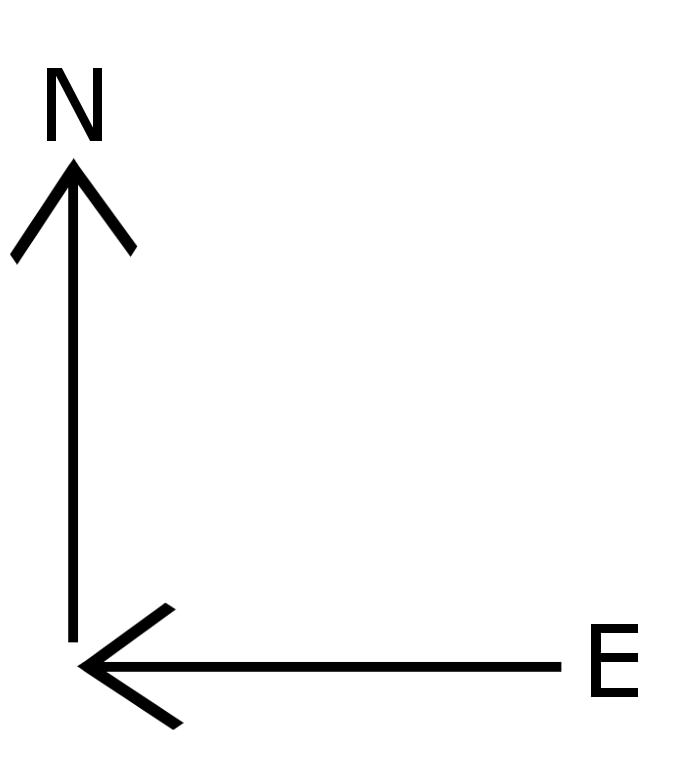9.6 速率
章节大纲
-
Ramey and her mom were driving down this highway at 45 miles per hour, which is the limit on this road. As they approached this sign, Ramey’s mom put on the brakes and started to slow down so she could safely maneuver the upcoming curves in the road. This speed limit sign actually represents two components of motion: speed and direction.
::拉米和她妈妈每小时45英里开着这条高速公路,这是这条公路的极限。 当他们接近这个标志时,拉米的母亲踩上了刹车,开始减速,以便她能够安全地操纵道路上即将到来的曲线。 这个速度限制标志实际上代表了运动的两个组成部分:速度和方向。Speed and Direction
::速度和方向Speed tells you only how fast or slow an object is moving. It doesn’t tell you the direction the object is moving. The measure of both speed and direction is called velocity . Velocity is a vector . A vector is measurement that includes both size and direction. Vectors are often represented by arrows. When using an arrow to represent velocity, the length of the arrow stands for speed, and the way the arrow points indicates the direction.
::速度只告诉您一个对象移动的速度或速度。 它没有告诉您该对象移动的方向。 速度和方向的度量被称为速度。 速度是矢量。 矢量包括大小和方向。 矢量通常由箭头代表。 当使用箭头代表速度时, 箭头的长度代表速度, 箭头的长度代表速度, 箭头点指示方向的方式也代表速度 。Using Vector Arrows to Represent Velocity
::使用矢量箭头代表速度The arrows in the Figure represent the velocity of three different objects. Arrows A and B are the same length but point in different directions. They represent objects moving at the same speed but in different directions. Arrow C is shorter than arrow A or B but points in the same direction as arrow A. It represents an object moving at a slower speed than A or B but in the same direction as A.
::图中的箭头代表三个不同对象的速度。箭头A和箭头B的长度相同,但指向不同的方向。箭头A和B代表以相同速度移动的物体,但指向不同的方向。箭头C比箭头A或B短,指向的方向与箭头A相同。箭头A和B代表以比A或B慢的速度移动的物体,但指向与A相同的方向。Differences in Velocity
::速度差异Objects have the same velocity only if they are moving at the same speed and in the same direction. Objects moving at different speeds, in different directions, or both have different velocities. Look again at arrows A and B from the Figure . They represent objects that have different velocities only because they are moving in different directions. A and C represent objects that have different velocities only because they are moving at different speeds. Objects represented by B and C have different velocities because they are moving in different directions and at different speeds.
::对象只有以相同速度和同一方向移动时才具有相同的速度。以不同速度、不同方向或两者都有不同速度移动的物体。再次查看图中的箭头A和B。它们代表的物体速度不同,只是因为它们向不同方向移动。A和C代表的物体速度不同,只是因为它们以不同速度移动。B和C所代表的物体速度不同,因为它们向不同方向和以不同速度移动。Q: Jerod is riding his bike at a constant speed. As he rides down his street he is moving from east to west. At the end of the block, he turns right and starts moving from south to north, but he’s still traveling at the same speed. Has his velocity changed?
::问题:耶洛德正以不变的速度骑着自行车。 当他骑着自己的街道从东向西移动时,他正从东向西移动。 在街区的尽头,他右转,开始从南向北移动,但他仍然以同样的速度旅行。 他的速度有变化吗?A: Although Jerod’s speed hasn’t changed, his velocity has changed because he is moving in a different direction.
::答:虽然耶洛德的速度没有改变, 但他的速度已经改变, 因为他正在向另一个方向移动。Q: How could you use vector arrows to represent Jerod’s velocity and how it changes?
::问题:你如何使用矢量箭头来代表Jerod的速度及其变化?A: The arrows might look like this:
::A:箭头可能看起来是这样的:Launch the PLIX Interactive below and try to use the vector arrows to illustrate the bike messenger's velocity throughout his day:
::启动下面的 PLIX 互动, 并尝试使用矢量箭头来说明自行车送信员全天的速度 :Calculating Average Velocity
::计算平均速率You can calculate the average velocity of a moving object that is not changing direction by dividing the the object travels by the time it takes to travel that distance. You would use this formula:
::您可以计算一个不改变方向的移动对象的平均速度,通过将对象旅行时间除以该距离旅行所需的时间。您将使用此公式:
::速度 = 远距离时间This is the same formula that is used for calculating average speed. It represents velocity only if the answer also includes the direction that the object is traveling.
::这是用来计算平均速度的相同公式。 它代表速度, 只有当答案也包含对象行驶的方向时 。Let’s work through a sample problem. Toni’s dog is racing down the sidewalk toward the east. The dog travels 36 meters in 18 seconds before it stops running. The velocity of the dog is:
::让我们来研究一下抽样问题。 托尼的狗正沿着人行道向东奔跑。 这只狗在停止跑步前的18秒内行走36米。 狗的速度是:
::速度 = 远时= 36 m18 s= 2 m/s 东Note that the answer is given in the SI unit for velocity, which is m/s, and it includes the direction that the dog is traveling.
::请注意,答案是按速度(m/s)在SI单元中给出的,它包括狗的行驶方向。Q: What would the dog’s velocity be if it ran the same distance in the opposite direction but covered the distance in 24 seconds?
::问:如果狗在相反方向跑同样的距离,却在24秒内到达距离,那狗的速度会如何?A: In this case, the velocity would be:
::A:在这种情况下,速度是:
::速度=远距离时间=36米24秒=1.5米/秒西Watch the video below to gain a better understanding of the relationship between speed, velocity and :
::观察下面的录像, 以便更好地了解速度、速度与速度之间的关系:Summary
::摘要-
Velocity is a measure of both speed and direction of motion. Velocity is a vector, which is a measurement that includes both size and direction.
::速度是运动速度和方向的量度,速度是矢量,包括大小和方向。 -
Velocity can be represented by an arrow, with the length of the arrow representing speed and the way the arrow points representing direction.
::箭头可以代表速度,箭头长度代表速度,箭头点代表方向。 -
Objects have the same velocity only if they are moving at the same speed and in the same direction. Objects moving at different speeds, in different directions, or both have different velocities.
::对象只有以相同速度向同一方向移动时,其速度才相同。物体以不同速度、不同方向或两种方向移动时,其速度不同。 -
The average velocity of an object moving in a constant direction is calculated with the formula:
. The SI unit for velocity is m/s, plus the direction the object is traveling.
::向恒定方向移动的物体的平均速度以公式计算:速度=距离时间。速度的 SI 单位是 m/s, 加上天体的飞行方向。
Review
::回顾-
What is velocity?
::什么是速度? -
How does velocity differ from speed? Why is velocity a vector?
::速度与速度有何不同?为什么速度是矢量? -
Explain how an arrow can be used to represent velocity.
::解释箭头如何代表速度。 -
Use vector arrows to represent the velocity of a car that travels north at 50 mi/h and then travels east at 25 mi/h.
::使用矢量箭头代表汽车以50米/小时向北行驶,然后以25米/小时向东行驶的速度。 -
Another car travels northwest for 2 hours and covers a distance of 90 miles. What is the average velocity of the car?
::另一辆汽车西北行驶2小时,距离90英里。
-
Velocity is a measure of both speed and direction of motion. Velocity is a vector, which is a measurement that includes both size and direction.


